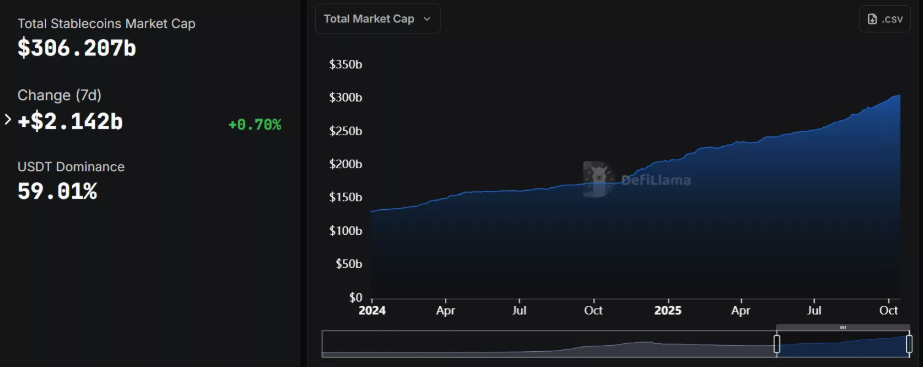Stablecoins Provide Stability Amid Market Crash, Matrixport Reports
On-chain analysis firm Matrixport has reported that stablecoins have continued to play a key role in maintaining crypto market liquidity despite recent turbulence. The report highlights that inflows into major stablecoins like USDT and USDC have reached $74 billion this year, helping to cushion the impact of broader market declines.
The findings come after a significant market downturn on October 14, which saw Bitcoin and Ethereum fall below key thresholds. While major tokens experienced heavy losses and short positions increased across altcoins, the stablecoin sector demonstrated resilience and continued growth.
Matrixport noted that Tether’s USDT rose to a market capitalization of $180.6 billion, while Circle’s USDC grew to $76.1 billion. Combined, these figures represent a major portion of the stablecoin market, which now exceeds $300 billion in total value.
📊Today’s #Matrixport Daily Chart – October 15, 2025 ⬇️
Stablecoin Surge Proves the Crypto Cycle Is Far From Over#Matrixport #CryptoMarket #DigitalAssets #LiquidityFlows #MarketCycle #MacroTrends pic.twitter.com/qwZiiS3dpi
— Matrixport Official (@Matrixport_EN) October 15, 2025
“Despite the recent crypto crash, stablecoin inflows remain one of the clearest signs that this is neither the end of crypto nor the end of this cycle,” Matrixport stated in its report.
Stablecoin Growth and Market Evolution
The report underlined the growing maturity of the stablecoin market, emphasizing how it has evolved into a structural component of the broader digital asset ecosystem. Five years ago, the total market capitalization of all stablecoins was around $4 billion. Today, that figure has surpassed $300 billion, underscoring the rapid institutional and retail adoption of digital payment rails backed by fiat currency.
In 2025 alone, the stablecoin sector added $100 billion in market value, driven by rising global adoption of blockchain-based payment solutions and cross-border settlements. These instruments have become critical to preserving liquidity when market sentiment turns negative.
Matrixport also pointed to ongoing de-dollarization trends, arguing that stablecoins are increasingly being used as on-ramps into higher-yielding crypto assets and as hedges against the weakening of traditional currencies. While some institutions, including JPMorgan, have suggested that stablecoins reinforce U.S. dollar dominance, Matrixport contends that they are simultaneously enabling more decentralized and multi-currency financial ecosystems.
Outlook for the Digital Asset Market
Matrixport’s analysis suggests that the growth in stablecoin activity demonstrates a broader maturation of the crypto industry, where liquidity no longer depends solely on speculative trading of volatile assets. Instead, stablecoins have become the infrastructure supporting lending, decentralized finance, and payments worldwide.

The firm acknowledged that the current $74 billion in new inflows remains far below long-term forecasts like the U.S. Treasury’s projected $3 trillion in stablecoin circulation. Still, the trajectory indicates strong global adoption and integration into traditional finance systems.
The report also referenced predictions made earlier in 2025 by Bo Hines, Executive Director of the President’s Council of Advisers on Digital Assets, who suggested that new regulation under the GENIUS Act could push total crypto market value to $15–20 trillion in the coming years, with stablecoins leading the next growth phase.
Conclusion
Despite market volatility, Matrixport’s findings show that stablecoins continue to serve as the foundation of liquidity and stability within the crypto economy. Their expanding market share reflects an industry increasingly insulated from speculative shocks and supported by real-world financial use cases.












